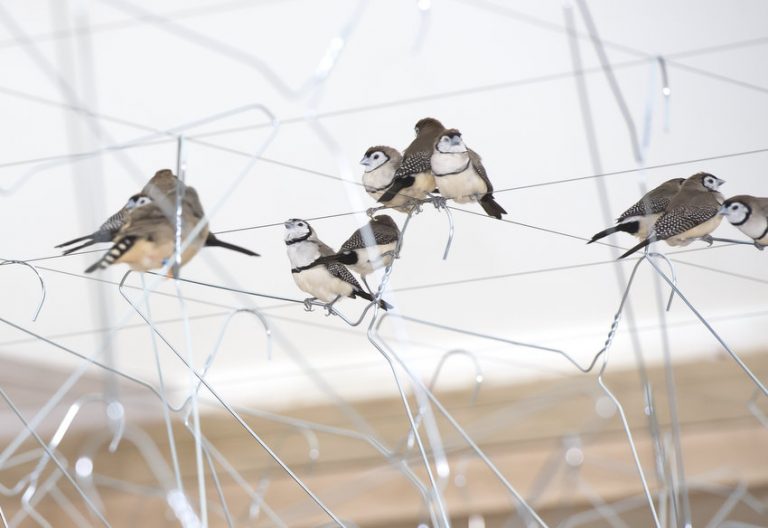We acknowledge the Traditional Owners of the land on which the Queensland Art Gallery | Gallery of Modern Art stands and recognise the creative contribution First Australians make to the art and culture of this country.

Céleste Boursier-Mougenot / France b.1961 / From here to ear (v.13) 2010 / Five octagonal structures (each made in maple and plywood), harpsichord strings, piano tuning pins, audio system (contact microphones, amplifiers, guitar processors and speakers), coat hangers, feeding trays and bowls, seeds, water, nests, sand and grass / 400 x 1978 x 1852.1cm (installed, variable) / Purchased 2011. Queensland Art Gallery Foundation / Collection: Queensland Art Gallery | Gallery of Modern Art / © Céleste Boursier-Mougenot
Céleste Boursier-MougenotFrom here to ear (v.13) 2010
Not Currently on Display
Céleste Boursier-Mougenot’s installations combine the technical with the aesthetic and sensorial; he refers to them as functioning like a ‘dispositif’ rather than an installation. The term, loosely translated as device or structure, foregrounds the potential to engage viewers in both the operational and aesthetic components of a work. From here to ear (v.13) explicitly orchestrates a space for listening and experiencing. Instruments have been constructed and tuned to create an environment for finches to feed, fly, rest and make music through interacting with them. Rather than ‘participation’ on the part of the viewer, the artist is particularly interested in the quality of human attention that arises through experiencing the installation.
Four species of Australian finches inhabit the art work: the zebra finch (Taeniopygia guttata), Gouldian finch (Erythrura gouldiae), black-throated finch (Poephila cincta), and the crimson finch (Neochmia phaeton).
Céleste Boursier-Mougenot is a French artist and composer who creates large-scale acoustic installations and environments that draw on the forces of nature and rhythms of everyday life to produce art and music. Born in 1961 in Nice, Boursier-Mougenot started out as a musician and composer before branching out into theatre, set design and lighting.
Céleste Boursier-Mougenot has forged an art practice that merges the visual and the auditory. He considers music the medium through which humans most commonly experience the intangible and abstract. He aims to create the conditions for experiencing what composer and innovator of ambient music Brian Eno called ‘the long now’, by interrupting the constant assault of sensory data which passes for experience. A simple analogy is the experience of ‘live’ music with its sense of ‘being there’, in a spatial and sensory sense, which goes beyond the experience of listening, as Boursier-Mougenot underlines: ‘Live music, produced live and where we are present, is among the phenomena which have the property of amplifying our feeling of the present moment’. The artist aims for this harmony of process and effect to encourage viewers ‘to witness their own present time’.
Discussion Questions
If the finches could compose music for the humans they see walking through the gallery, how do you think the music would sound? What instruments would they use? What about the tempo, beat and volume?
Activities
1. Draw a diagram of a nesting place in which you think the finches would like to rest, combining at least one of the materials from Boursier-Mougenot’s installation.
2. Create a non-objective (abstract) drawing using expressive lines and marks to represent the movements and sounds made by the finches as they interact with their musical environment. Consider exploring and developing the drawing further by adding colour, or experimenting with printmaking or painting.